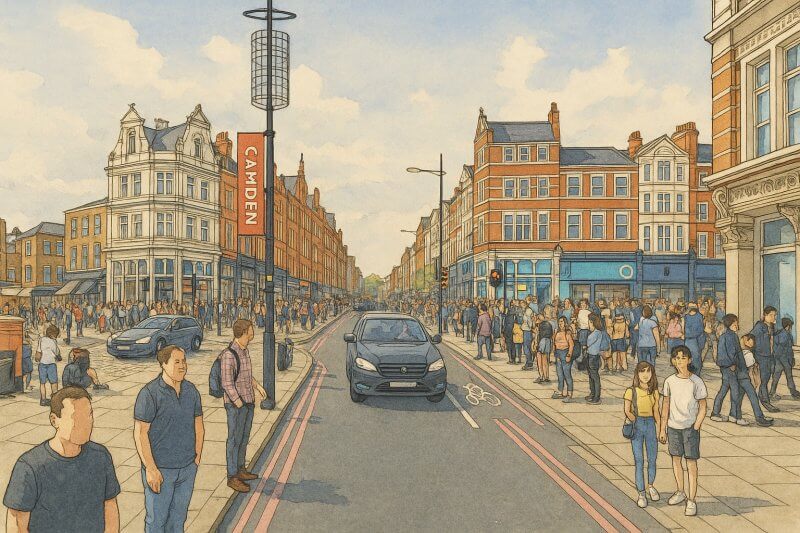
The London Borough of Camden: A Cultural Powerhouse in the Heart of the Capital, London
Where is Camden?
The London Borough of Camden is centrally located, forming a crucial part of Inner London. It stretches from the busy heart of the West End to the leafy edges of Hampstead Heath, offering a rich and varied experience across its area.To the north, Camden borders Barnet, while Islington lies to the east. On the south, it meets the City of Westminster, and to the west, it adjoins Brent. This strategic position gives Camden a unique character-part central metropolis, part tranquil suburb.
Size and Population
The borough spans approximately 22 square kilometres (8.5 square miles). According to the most recent data, Camden has a population of around 275,000 residents. It's a borough known for its diversity, both demographically and architecturally, offering everything from grand Georgian terraces to bustling multicultural high streets.A Brief History of Camden
The London Borough of Camden was officially formed in 1965 through the amalgamation of three former metropolitan boroughs: Hampstead, Holborn, and St Pancras. However, the area's history stretches much further back.In medieval times, much of Camden was rural, with settlements dotted along the River Fleet and on the hills to the north. With the growth of London in the 18th and 19th centuries, Camden became a hub for industry, especially around King's Cross and Euston, where canals and railways turned it into a centre for goods transport and manufacture.
The arrival of the Regent's Canal in the early 19th century helped establish Camden Town as a lively centre of commerce and creativity-an energy that still defines the borough today.
How Camden got its name
Camden takes its name from Camden Town, which in turn was named after Charles Pratt, 1st Earl Camden. In 1791, Pratt began developing the area, which at the time was semi-rural. He named it after his title, which derived from his estate in Chislehurst, Kent.Major roads in Camden
Several key roads cut through Camden, connecting the borough internally and with the wider city:- Euston Road (A501) - One of the major east-west arteries through Central London.
- Camden Road (A503) - Connecting Camden Town to Holloway and the A1.
- Hampstead Road - Runs south toward Tottenham Court Road.
- Kentish Town Road - A lively high street linking Camden Town to Tufnell Park.
- Finchley Road (A41) - A key north-west route leading to Brent Cross and beyond.
The Character of Camden
Camden is incredibly diverse in character. In the south, around Holborn and Bloomsbury, you'll find academic institutions, museums, and historic architecture. King's Cross and Euston are bustling transport hubs and centres for redevelopment, while Camden Town is world-famous for its alternative culture, markets, and live music.Further north, Hampstead and Belsize Park offer a much more residential and affluent vibe, with leafy streets, historic homes, and panoramic views from Hampstead Heath. The borough is thus a mix of commercial, residential, cultural, and retail zones.
Map of The London Borough of Camden
Streets in Camden
Major sights and attractions in Camden
Camden is brimming with iconic destinations that draw both tourists and locals:- Camden Market - A collective term for several adjacent markets in Camden Town, offering everything from vintage fashion to international street food.
- Regent's Canal - A picturesque walking and cycling route that runs through the borough.
- The British Museum - Located in Bloomsbury, this world-class museum is home to millions of historical artefacts.
- Hampstead Heath - A vast green space ideal for walking, swimming in natural ponds, or enjoying city views from Parliament Hill.
- ZSL London Zoo - Situated in Regent's Park, this is one of the world's oldest zoos.
- The Roundhouse - A legendary performing arts venue, known for music, theatre, and cultural events.
- King's Cross and Granary Square - A hub of regeneration with fountains, restaurants, and the Coal Drops Yard shopping and dining area.
- Freud Museum - The home of Sigmund Freud in Hampstead, now a fascinating museum of psychoanalysis.
Underground Stations in Camden
Camden is exceptionally well served by the London Underground, with stations on five key lines:- Camden Town (Northern Line)
- Chalk Farm (Northern Line)
- Mornington Crescent (Northern Line)
- Euston (Victoria and Northern Lines, and National Rail)
- Euston Square (Circle, Hammersmith & City, and Metropolitan Lines)
- King's Cross St Pancras (Northern, Victoria, Piccadilly, Circle, Hammersmith & City, and Metropolitan Lines)
- Russell Square (Piccadilly Line)
- Tottenham Court Road (Central, Northern, and Elizabeth Lines)
- Belsize Park (Northern Line)
- Swiss Cottage (Jubilee Line)
- Finchley Road (Jubilee and Metropolitan Lines)
- West Hampstead (Jubilee Line and National Rail)

Painting of Camden at Camden Market Locks
Fun Fact: Camden's Musical Legacy
Camden has a rich musical history and is often considered the spiritual home of Britpop and punk rock. Legendary artists like Amy Winehouse, Blur, and The Clash have roots here. The borough's many music venues-like the Electric Ballroom, KOKO, and Dingwalls-have hosted countless iconic performances.There's even a statue of Amy Winehouse in the heart of Camden Market, paying tribute to the singer who lived in the area and helped shape its artistic identity.